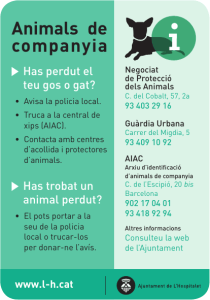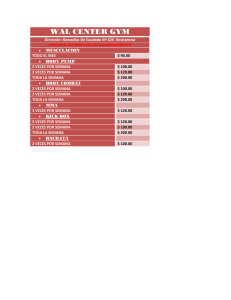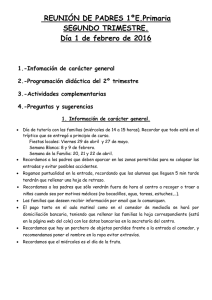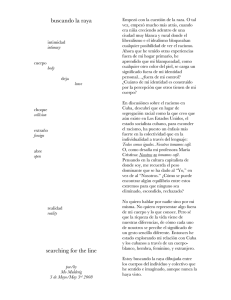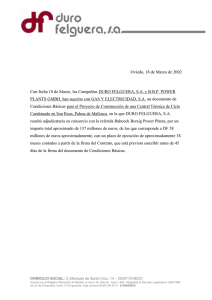Unit: 10 - Big Idea 14: Characteristics of Living Things
Anuncio
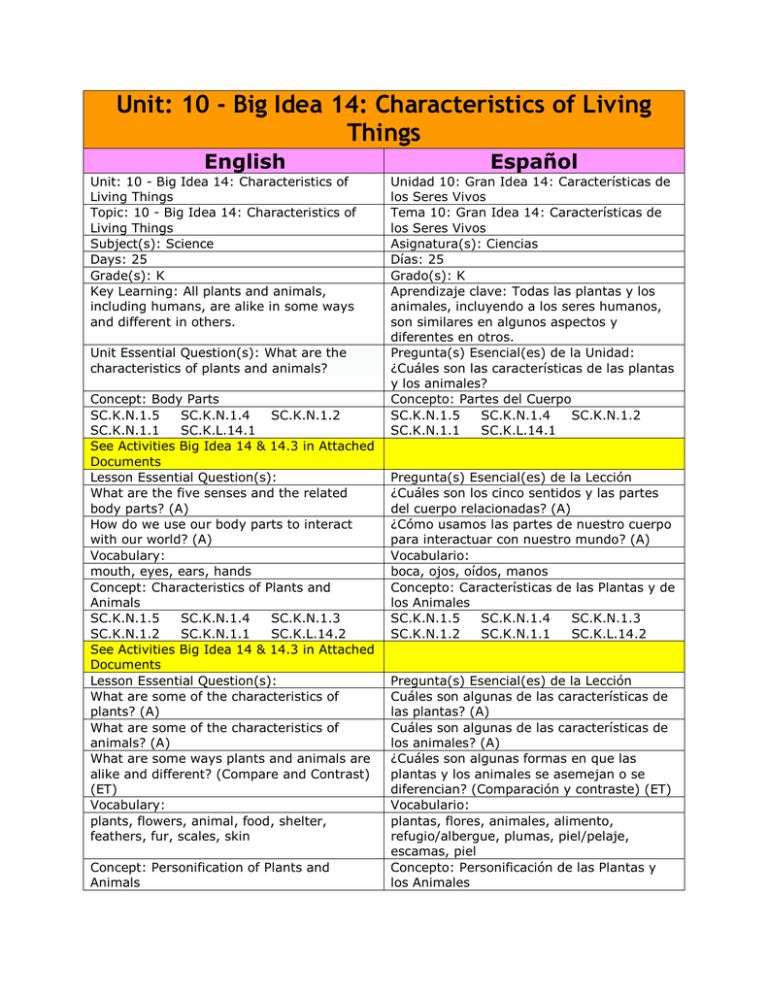
Unit: 10 - Big Idea 14: Characteristics of Living Things English Unit: 10 - Big Idea 14: Characteristics of Living Things Topic: 10 - Big Idea 14: Characteristics of Living Things Subject(s): Science Days: 25 Grade(s): K Key Learning: All plants and animals, including humans, are alike in some ways and different in others. Unit Essential Question(s): What are the characteristics of plants and animals? Concept: Body Parts SC.K.N.1.5 SC.K.N.1.4 SC.K.N.1.2 SC.K.N.1.1 SC.K.L.14.1 See Activities Big Idea 14 & 14.3 in Attached Documents Lesson Essential Question(s): What are the five senses and the related body parts? (A) How do we use our body parts to interact with our world? (A) Vocabulary: mouth, eyes, ears, hands Concept: Characteristics of Plants and Animals SC.K.N.1.5 SC.K.N.1.4 SC.K.N.1.3 SC.K.N.1.2 SC.K.N.1.1 SC.K.L.14.2 See Activities Big Idea 14 & 14.3 in Attached Documents Lesson Essential Question(s): What are some of the characteristics of plants? (A) What are some of the characteristics of animals? (A) What are some ways plants and animals are alike and different? (Compare and Contrast) (ET) Vocabulary: plants, flowers, animal, food, shelter, feathers, fur, scales, skin Concept: Personification of Plants and Animals Español Unidad 10: Gran Idea 14: Características de los Seres Vivos Tema 10: Gran Idea 14: Características de los Seres Vivos Asignatura(s): Ciencias Días: 25 Grado(s): K Aprendizaje clave: Todas las plantas y los animales, incluyendo a los seres humanos, son similares en algunos aspectos y diferentes en otros. Pregunta(s) Esencial(es) de la Unidad: ¿Cuáles son las características de las plantas y los animales? Concepto: Partes del Cuerpo SC.K.N.1.5 SC.K.N.1.4 SC.K.N.1.2 SC.K.N.1.1 SC.K.L.14.1 Pregunta(s) Esencial(es) de la Lección ¿Cuáles son los cinco sentidos y las partes del cuerpo relacionadas? (A) ¿Cómo usamos las partes de nuestro cuerpo para interactuar con nuestro mundo? (A) Vocabulario: boca, ojos, oídos, manos Concepto: Características de las Plantas y de los Animales SC.K.N.1.5 SC.K.N.1.4 SC.K.N.1.3 SC.K.N.1.2 SC.K.N.1.1 SC.K.L.14.2 Pregunta(s) Esencial(es) de la Lección Cuáles son algunas de las características de las plantas? (A) Cuáles son algunas de las características de los animales? (A) ¿Cuáles son algunas formas en que las plantas y los animales se asemejan o se diferencian? (Comparación y contraste) (ET) Vocabulario: plantas, flores, animales, alimento, refugio/albergue, plumas, piel/pelaje, escamas, piel Concepto: Personificación de las Plantas y los Animales SC.K.N.1.5 SC.K.N.1.2 SC.K.N.1.1 SC.K.L.14.3 See Activities Big Idea 14 & 14.3 in Attached Documents Lesson Essential Question(s): How can I tell the difference between real and make-believe animals in books and movies? (A) How would you recognize make-believe characteristics in plants and animals? (Error Analysis) (ET) Vocabulary: personification, realistic, make-believe Additional Information: Harcourt Science: Body Parts - pp. 14-15; Characteristics of Plants and Animals - pp. 132-133, 136-139, 232-269, 276-282, 292301; Personification of Plants and Animals pp. 239, 266, R7 SC.K.N.1.5 SC.K.L.14.3 SC.K.N.1.2 SC.K.N.1.1 Pregunta(s) Esencial(es) de la Lección ¿Cómo se puede saber la diferencia entre los animales reales y los ficticios en libros y películas? (A) ¿Cómo se reconocen las características ficticias en las plantas y en los animales? (Análisis de Error) (ET) Vocabulario: personificación, realista, fantasía/ficticio Información adicional: Harcourt Science: Partes del Cuerpo - págs. 14-15; Características de las Plantas y de los Animales - págs. 132-133, 136-139, 232269, 276-282, 292-301; Personificación de las Plantas y los Animales - págs. 239, 266, R7 Sciencesaurus: Grade 2/3 pp. 80-127 Sciencesaurus: Grado 2/3 págs. 80-127 Writing in Science: Escritura en Ciencias Have students fold a sheet of paper in half, Pida a los estudiantes que doblen una hoja then fold again, and one more time. (giving de papel por la mitad, y luego la doblen de 6 squares when the paper is opened up) nuevo, y una vez más. (obteniendo 6 Have students write air water light food cuadrados cuando el papel se abre) space and shelter one in each square. Have Pida a los estudiantes que escriban aire, students draw a picture of a plant or an agua, luz, alimento, espacio y refugio en animal utilizing each need. cada cuadrado. Pida a los estudiantes que hagan un dibujo de una planta o un animal que usa cada necesidad. Concept 1 Helpful Websites: Concepto 1 - Sitios Webs útiles: 1. http://kidshealth.org/kid/ (click on "How the Body Works") 2. http://www.everythingpreschool.com/themes/bodyparts/index.htm Concepts 2-3 Helpful Websites: Conceptos 2-3 - Sitios Webs útiles: 1.http://www.bbc.co.uk/schools/scienceclips/ages/6_7/plants_animals_env.shtml 2. http://www.sfscience.com/english/grade_K/unit_A/chap_1/act_1/1.htm(click go on for more) 3. http://www.sfscience.com/english/grade_K/unit_A/chap_2/act_1/1.htm(click go on for more) 4.http://www.bbc.co.uk/schools/scienceclips/ages/5_6/growing_plants.shtml(click go on for more) 5. http://www.sfscience.com/english/grade_K/unit_A/chap_3/act_3/1.htm The Senses Los Sentidos Sensory Concentration Concentración Sensorial Get an Earful Obteniendo un Regaño Hearing Class Activity Actividad de Audición de la Clase Taste Class Activity Actividad de Saborear de la Clase Smell Class Activity Actividad de Oler de la Clase Touch Class Activity Actividad de Tocar de la Clase I Know That Vision and Sound Conozco esa Visión y Sonido Sound and Hearing Sonido y Audición Online Storybook Dottie's Garden Resources: Activites Big idea 14.3 Activities Big Idea 14 Additional Unit Resources Vocabulary Report • mouth - The body part that we use to taste. • personification - Giving an animal or plant human characteristics and/or behaviors. • plants - Living things that make their own food using light from the sun. They need air, water, light, and a place to live. • eyes - The body part that we use to see. • realistic - Can happen in real life. • flowers - The parts of a plant that makes the seeds. • make-believe - Can not happen in real life. • animal - Living things that do not make their own food. They need air, water, light, and a place to live. • ears - The body part that we use to hear. • food - Provides living things with the nutrients including vitamins that they need for energy and growth. • hands - The body part that we use to touch/feel. • shelter - The place in which an animal lives. • feathers - The protective body covering of birds. • fur - A protective body covering of thick hair. • scales - A protective body covering that protects animals such as fish. • skin - An organ that covers the body that protects the insides of animals. Libro de cuentos en línea Dottie's Garden Recursos Actividades Gran Idea 14.3 Actividades Gran Idea 14 Recursos Adicionales de la Unidad Informe de Vocabulario • boca - Parte del cuerpo que utilizamos para probar. • personificación - Dar características y/o comportamientos humanos a un animal o a una planta. • plantas - Seres vivos que hacen su propia comida usando la luz del sol. Necesitan aire, agua, luz, y un lugar para vivir. • ojos - Parte del cuerpo que utilizamos para ver. • realista - Puede suceder en la vida real. • flores - Partes de una planta que produce las semillas. • ficticio/fantasía - No puede pasar en la vida real. • animal - Seres vivos que no producen su propio alimento. Necesitan aire, agua, luz, y un lugar para vivir. • oídos - Parte del cuerpo que usamos para escuchar. • alimentos – Provee a los seres vivos con los nutrientes incluyendo las vitaminas que necesitan para la energía y el crecimiento. • manos - Parte del cuerpo que usamos para tocar/sentir. • refugio/albergue - Lugar en que vive un animal. • plumas - Cuerpo de protección que cubre a las aves. • piel/pelaje - Cuerpo de protección que cubre con pelo grueso. • escamas – Cuerpo de protección que cubre y protege a animales como los peces. • piel - Órgano que cubre el cuerpo que protege el interior de los animales.
